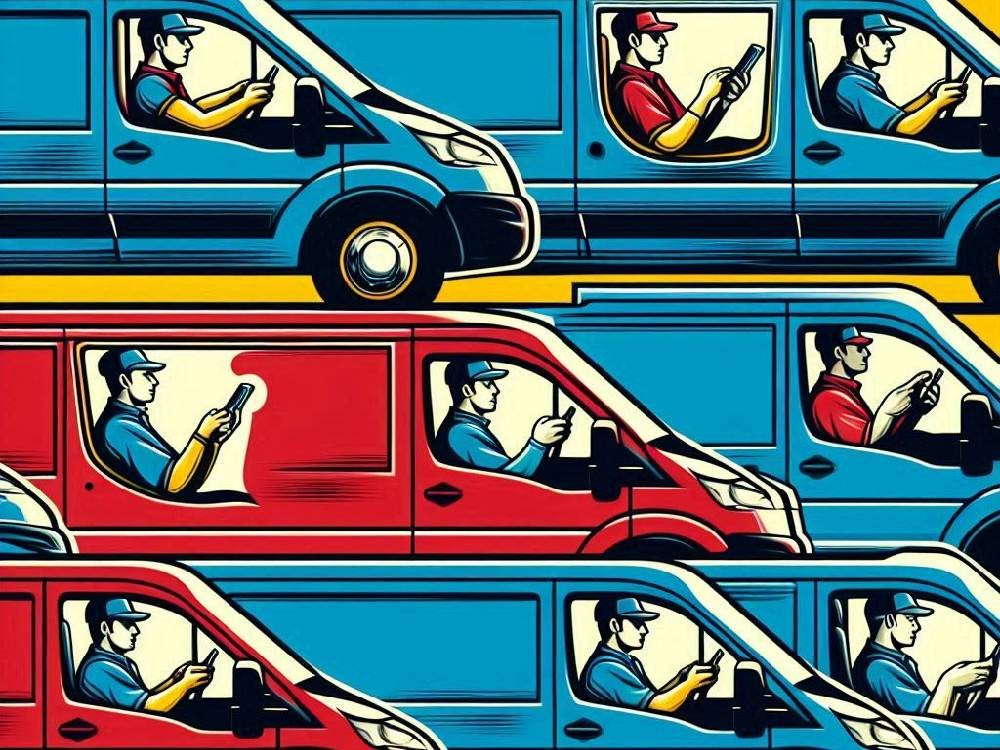Introduction
Distracted driving is a growing concern, especially among van drivers in the UK.
Recent research reveals that over half of UK van drivers are still checking their phones while driving.
This behaviour puts both drivers and other road users at risk.
Despite advancements in hands-free technology and stricter laws, many drivers continue to ignore the rules.
Here’s what you’ll discover in this article:
- How widespread mobile phone use is among UK van drivers.
- The legal and financial consequences of being caught.
- Why hands-free technology is underutilised despite being widely available.
- The serious safety hazards linked to distracted driving.
- Practical tips to avoid distractions and reduce van insurance costs.
The Prevalence Of Phone Use Among UK Van Drivers
Van drivers are essential to keeping the UK moving.
But there’s a troubling trend.
57% of van drivers admit to checking their phones while driving.
Let that sink in for a moment.
This figure, while 7% lower than last year, is still alarmingly high.
The Department for Transport (DfT) found van drivers are twice as likely to use their phones.
This rate is significantly higher than other drivers.
Think about the implications of that.
Heavier vehicles.
Busier schedules.
And now, distracted driving.
These elements, when combined, ultimately create the perfect storm for potential accidents.
However, this issue isn’t just about breaking the law.
More importantly, it’s about taking the necessary steps to protect lives on the road.
Van Drivers: The Law On Mobile Phone Use While Driving
The laws surrounding phone use while driving have tightened significantly.
In 2022, new regulations made it illegal to hold or use devices like phones or tablets while driving.
Here’s the key takeaway:
The law applies whether you’re online or offline.
Even if your vehicle is stopped in traffic or at a red light, you can’t use a device in your hand.
And there’s more.
If your engine automatically shuts off when stationary, the law still applies.
So, what happens if you’re caught?
Six penalty points.
A £200 fine.
And if you’re a new driver, six points could mean losing your licence altogether.
This is a risk no van driver can afford to take.
Hands-Free Technology For Van Drivers: A Missed Opportunity?
Van drivers aren’t short on options to avoid distracted driving.
The latest research reveals that 93% of van drivers have access to hands-free technology.
And nearly all—98%—use it at least once a day.
So, why are so many still reaching for their phones?
The answer might surprise you.
Old habits die hard.
Some drivers find hands-free systems inconvenient or less reliable than their phones.
Others feel pressured to respond to messages instantly.
But here’s the reality:
Breaking this habit is not just essential for safety.
It’s also critical for your wallet.
Distracted driving increases the likelihood of accidents, which can drive up your insurance premiums.
Safe driving habits, on the other hand, can help lower your costs.
Looking to save on your premiums?
Read this guide on How Telematics Devices Can Save You Money on Van Insurance.
The Safety Hazards Of Distracted Driving
Distracted driving isn’t just a legal issue.
It’s a safety crisis.
Drivers who use phones—whether hand-held or hands-free—are four times more likely to crash.
Let that sink in.
This behaviour significantly reduces hazard detection.
It also increases reaction times.
Imagine this:
A split-second delay can mean the difference between stopping in time and causing a serious accident.
For van drivers, the risks are even greater.
Larger vehicles take longer to stop.
The consequences of distracted driving are magnified.
No text or call is worth the potential devastation.
Practical Tips To Stay Safe And Avoid Fines
So, how can van drivers stay safe and compliant?
Here are some practical steps:
- Use built-in hands-free technology.
Familiarise yourself with your vehicle’s features to minimise the need to touch your phone. - Enable driving mode on your phone.
Apps like Apple’s “Do Not Disturb While Driving” or Android’s “Focus Mode” can block notifications automatically. - Invest in telematics devices.
These devices monitor driving behaviour and can reward safe habits with lower insurance premiums. - Plan your route in advance.
Setting up your navigation before starting your journey eliminates the need to fiddle with devices. - Keep your phone out of reach.
Place it in the glove box or a bag to avoid temptation.
These small changes can make a big difference.
Not only can they protect your safety, but they can also save you money on cheap van insurance.
How Safe Driving Impacts Van Insurance Costs
Here’s something every van driver should know:
Insurance companies reward safe drivers.
By avoiding fines, points, and accidents, drivers show responsibility.
This behaviour positively reflects on their driving habits.
As a result, many insurers are more likely to offer discounts to those with clean records.
Telematics devices, in particular, can track your driving habits and provide detailed reports to insurers.
The result?
You could qualify for very cheap van insurance by proving you’re a low-risk driver.
Safety isn’t just about compliance.
It’s a smart financial decision.
Want more tips on lowering your premiums?
Check out our blog on 10 Simple Hacks to Instantly Lower Your Van Insurance and Save Big.
Conclusion
The Road Ahead for UK Van Drivers
The statistics, without a doubt, paint a clear picture.
Distracted driving continues to be a major issue for van drivers across the UK, posing ongoing challenges to road safety.
Moreover, the associated risks are far too significant to overlook.
Even more importantly, embracing safe driving habits significantly enhances safety.It also provides a practical way to lower van insurance costs.
It’s time to make a change.
Ready to dive deeper into related topics?
Here are some must-read blogs:
Take the first step toward safer, smarter driving today.





